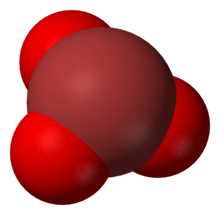Potassium bromate
Potassium bromate (KBrO3), is a bromate of potassium and takes the form of white crystals or powder. It is a strong oxidizing agent.
 | |||
| |||
| Names | |||
|---|---|---|---|
| IUPAC name
Potassium bromate | |||
| Other names
Potassium bromate(V) Bromic acid, potassium salt | |||
| Identifiers | |||
3D model (JSmol) |
|||
| ChEBI | |||
| ChemSpider | |||
| ECHA InfoCard | 100.028.936 | ||
| EC Number |
| ||
| E number | E924 (glazing agents, ...) | ||
| KEGG | |||
PubChem CID |
|||
| RTECS number |
| ||
| UNII | |||
| UN number | 1484 | ||
CompTox Dashboard (EPA) |
|||
| |||
| |||
| Properties | |||
| KBrO3 | |||
| Molar mass | 167.00 g/mol | ||
| Appearance | white crystalline powder | ||
| Density | 3.27 g/cm3 | ||
| Melting point | 350 °C (662 °F; 623 K) | ||
| Boiling point | 370 °C (698 °F; 643 K) (decomposes) | ||
| 3.1 g/100 mL (0 °C) 6.91 g/100 mL (20 °C) 13.3 g/100 mL (40 °C) 49.7 g/100 mL (100 °C) | |||
| Solubility | Insoluble in acetone | ||
| −52.6·10−6 cm3/mol | |||
| Structure | |||
| hexagonal | |||
| Thermochemistry | |||
Std enthalpy of formation (ΔfH⦵298) |
-342.5 kJ/mol | ||
| Hazards | |||
| Safety data sheet | ICSC 1115 | ||
EU classification (DSD) (outdated) |
Carc. Cat. 2 Toxic (T) Oxidant (O) | ||
| R-phrases (outdated) | R45 R9 R25 | ||
| S-phrases (outdated) | S53 S45 | ||
| NFPA 704 (fire diamond) | |||
| Flash point | Non-flammable | ||
| Lethal dose or concentration (LD, LC): | |||
LD50 (median dose) |
157 mg/kg (oral, rat)[1] | ||
Except where otherwise noted, data are given for materials in their standard state (at 25 °C [77 °F], 100 kPa). | |||
| Infobox references | |||
Preparation
Potassium bromate is produced when bromine is passed through a hot solution of potassium hydroxide. This first forms unstable potassium hypobromite, which quickly disproportionates into bromide and bromate:[2]
- 3BrO−(aq) → 2Br−(aq) + BrO−
3(aq)
Electrolysis of potassium bromide solutions will also give bromate. Both processes are analogous to those used in the production of chlorates.
Potassium bromate is readily separated from the potassium bromide present in both methods owing to its much lower solubility; when a solution containing potassium bromate and bromide is cooled to 0°C, nearly all bromate will precipitate, while nearly all of the bromide will stay in solution.[2]
Uses in baking
Potassium bromate is typically used in the United States as a flour improver (E number E924). It acts to strengthen the dough and to allow higher rising. It is an oxidizing agent, and under the right conditions will be completely reacted to a form with a lower oxidation state in baking the bread. However, if too much is added, or if the bread is not baked long enough or not at a high enough temperature, then a residual amount will remain, which may be harmful if consumed.[3]
Potassium bromate might also be used in the production of malt barley, for which application the U.S. Food and Drug Administration (FDA) has prescribed certain safety conditions, including labeling standards for the finished malt barley product.[4]
It is a very powerful oxidizer (E° = 1.5 volts, comparable to potassium permanganate).
Regulation
Potassium bromate is classified as a category 2B carcinogen (possibly carcinogenic to humans) by the International Agency for Research on Cancer (IARC).[5]
Potassium bromate has been banned from use in food products in the European Union, Argentina, Brazil,[6] Canada, Nigeria, South Korea, Peru, and some other countries. It was banned in Sri Lanka in 2001,[7] China in 2005, and India in 2016.[8]
In the United States of America, it has not been banned. The FDA sanctioned the use of bromate before the Delaney clause of the Food, Drug, and Cosmetic Act—which bans potentially carcinogenic substances—went into effect in 1958. However, since 1991 the FDA has urged bakers to voluntarily stop using it. In California, a warning label is required when bromated flour is used.[9]
Japanese baked goods manufacturers stopped using potassium bromate voluntarily in 1980; however, Yamazaki Baking resumed its use in 2005, claiming they had new production methods to reduce the amount of the chemical which remained in the final product.[10]
References
- "Potassium bromate". ChemIDplus.
- "Synthesis, Separation and Purification of KBr and KBrO" (PDF). Harvard-Westlake School AP Chemistry Pre-Labs. Harvard-Westlake School. Archived from the original (PDF) on 16 May 2017. Retrieved 14 September 2016.
- Kurokawa, Y; Maekawa, A; Takahashi, M; Hayashi, Y (1990-07-01). "Toxicity and carcinogenicity of potassium bromate--a new renal carcinogen". Environmental Health Perspectives. 87: 309–335. doi:10.1289/ehp.9087309. ISSN 0091-6765. PMC 1567851. PMID 2269236.
- Section 172.730 Potassium Bromate, Food Additives Permitted for Direct Addition to Food for Human Consumption, US Code of Federal Regulations, US Food and Drug Administration
- IARC--Summaries & Evaluations: Potassium Bromate (Group 2B), International Agency for Research on Cancer
- "Dispõe sobre o uso do bromato de potássio na farinha e nos produtos de panificação" (in Portuguese).
- Bridges Across Borders, Environmental Law Alliance Worldwide
- "India bans use of cancer-causing additive, potassium bromate, in bread, other food". The Times of India. Retrieved 20 June 2016.
- California OEHHA Bromate Meets the Criteria for Listing Archived 2013-12-03 at the Wayback Machine
- AsiaPulse News: Japan's Yamazaki Baking to use potassium bromate in bread


